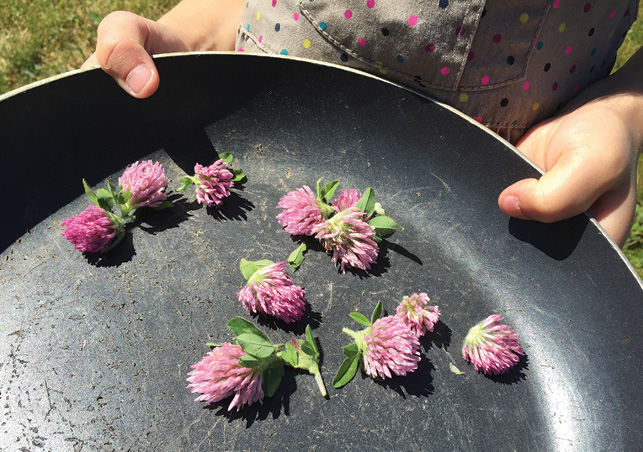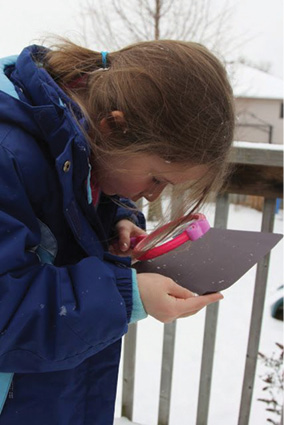Math Learning—and a Touch of Science—in the Outdoor World

You are here
Young children strive to understand the world around them. Outdoors, they can spend hours engaged in rich, imaginative play using nothing more than the natural materials they find. How many times have you emptied treasures from the pockets of a preschooler? Pebbles, pinecones, feathers, and leaves are wondrous and hold so much potential for math and science inquiry!
Discovery outdoors
The great outdoors is filled with rich opportunities for math learning—with a connection to science—that can interest and engage children in real-life problem solving. Children need to spend large blocks of time playing outside—classes in our program spend at least one hour outdoors every day. It’s amazing to see how children’s mathematical explorations and scientific observations outdoors inspire our indoor learning. We once spent several weeks examining the characteristics of the plants and trees around our school! The children’s initial interest in trees sparked hours of reading, researching, drawing, sculpting, and dramatizing different forest adventures. Outdoor exploration also complements emergent math—and science, too.
Here are some suggestions for integrating learning opportunities into play in natural spaces and for connecting outdoor explorations to children’s learning. Get ready to look at the outdoor world through a mathematical lens, with an eye for science!
Rethink your surroundings
 The design and contents of the outdoor play space are important. When children have access to different found and recycled objects, including logs cut from fallen trees (tree stumps), tires, and large stones, their imaginations guide activities. Allow children to control the direction of their play while engaging in big body movement. Complex learning occurs through children’s authentic planning and problem solving. They can line up tree stumps by size to make stair steps, roll them into certain locations to define a space, use them as platforms to jump from, and arrange them with stones and tires to create an obstacle course.
The design and contents of the outdoor play space are important. When children have access to different found and recycled objects, including logs cut from fallen trees (tree stumps), tires, and large stones, their imaginations guide activities. Allow children to control the direction of their play while engaging in big body movement. Complex learning occurs through children’s authentic planning and problem solving. They can line up tree stumps by size to make stair steps, roll them into certain locations to define a space, use them as platforms to jump from, and arrange them with stones and tires to create an obstacle course.
Include areas that contain sand, water, pea stone gravel, and other sensory materials. Place old tables outside to give children plenty of working space. Add tools such as tubing, buckets, shovels, pots, measuring cups, and spoons to encourage children to use math when talking about their actions and making plans for collaborative play. Engage children in math conversations as they use the materials to explore quantity and movement. Have children dictate recipes for mud stew, discuss measuring ingredients for leaf salad, or buy supplies from the “store.”
Use math tools outdoors
Many outdoor play areas have traditional vehicles and toys, like tricycles, wagons, trucks, and balls. Adding math tools encourages children to play in unexpected and more complex ways. Offer laminated ten frames, sorting trays, recycled checkerboards, hoops, and number lines. Teachers can scaffold activities as children incorporate the tools into their play. Loose natural materials, like stones and acorns, can be placed on ten frames to encourage counting; flowers can be organized on sorting trays by color and size; and sticks can be counted using a number line. Use chalk to draw a large hundreds grid on the pavement, or add natural loose parts along with dice or spinners to a checkerboard to inspire children to create number games together.
Be responsive to children’s observations and wonderings
 When playing with children, pay attention to their comments about the outdoor space. I note the questions children have (“How big is this tree?,” “How fast can you run?,” “Why are all those birds flying together?”) and then encourage and support their emergent projects. For example, we bring a tablet outside so the children can document and photograph events they observe, like the leaves changing colors and the geese migrating south for the winter, and then share their observations during whole group conversations.
When playing with children, pay attention to their comments about the outdoor space. I note the questions children have (“How big is this tree?,” “How fast can you run?,” “Why are all those birds flying together?”) and then encourage and support their emergent projects. For example, we bring a tablet outside so the children can document and photograph events they observe, like the leaves changing colors and the geese migrating south for the winter, and then share their observations during whole group conversations.
Teachers can clarify children’s questions and then help them plan an investigation to discover answers. Resources such as books and websites provide background knowledge and introduce appropriate math and science tools and vocabulary. Children see firsthand why math is important when they observe authentic purposes for it in their world. Vocabulary and traditional problem solving have more meaning when they’re applied to real situations.
When the children in my classroom were curious about the large trees in our playground, we practiced using standard tools (measuring tape) and nonstandard tools (connecting links) to measure the trunks. The children learned and remembered the word circumference—the distance around something—because it mattered to them in that moment. That day, I hadn’t intended to do a measurement activity with the children. But because I was responsive to their interests, we experienced a rich mathematical exploration that incorporated many learning standards.
Explore and sort collections
Encouraging children to keep collections of natural materials—like feathers, shells, or seed pods—is an easy way to integrate math and science into outdoor play. Children can identify common characteristics, like size, color, and shape, and then use sorting rules to group items. Children can also bring materials indoors for in-depth exploration and play. We keep collections in the various centers in our classroom so that the children can incorporate them into their daily activities. The objects can be added to geometric designs at the art table, placed on the light table for patterning, or examined with a magnifying glass in the science center. We encourage families to search their yards and neighborhoods for more materials, adding variety to what has already been gathered at school.
Notice patterns
Patterns are everywhere in nature! From the unique markings on animals to the cycle of the changing seasons, there are many ways children observe and document repetition in our world. Natural patterns can be complex, requiring children to think abstractly and interpret their surroundings in different ways. When a child observes the seasonal stages of leaf growth on a tree, there are many possibilities to connect their observations to math, science, and literacy. Unlike more common activities for patterning that might have only a few correct answers (coloring in boxes on a worksheet, beading on a string), exploring natural patterns encourages children to think deeply about what they are observing. Why does the pattern occur? Will the pattern change in any way? How does the pattern affect other parts of the natural world?
 Some patterns are more difficult to identify, and because the outdoor play area offers different experiences each day (depending on the weather, human interactions, and animal visitors), there are always new things to discover, interpret, and talk about.
Some patterns are more difficult to identify, and because the outdoor play area offers different experiences each day (depending on the weather, human interactions, and animal visitors), there are always new things to discover, interpret, and talk about.
Children can look closely at patterns by using tools like magnifying glasses and microscopes to examine rocks, leaves, and spiderwebs. In our classroom, the children took digital photos to create books about patterns they found in nature. They also copied and extended these patterns in their artwork (using pastels to draw what they saw outside and using loose parts to build the patterns). They communicated new understanding by blogging and tweeting with others about their nature-inspired math work. The children enjoyed connecting with other classes from around the country.
Conclusion
Children find joy in the wonders of nature. Use this excitement to create authentic, engaging, and accessible math and science experiences outdoors. When we open our hearts and minds to the possibilities of nature, we make learning fun and relevant for all children—right in their own backyards!
Photos courtesy of the author
Deanna Pecaski McLennan, PhD, is a kindergarten educator and author in Windsor, Ontario, Canada. She loves exploring mathematics through a play-, inquiry-based approach. She enjoys sharing her classroom practice and connecting with others using social media. @McLennan1977
